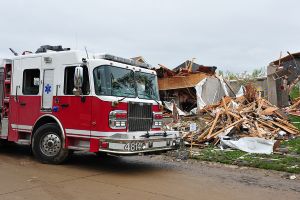 Equity is highlighted in priority two of the President's Management Agenda (PMA), Delivering Excellent, Equitable, and Secure Federal Services and Customer Experience, and is a theme throughout all PMA priorities. Disaster response is possibly the most critical place to ensure equity. While a disaster does level the playing field in some ways-no matter how much money you have it won't stop a tornado from hitting your house-the recovery from disasters is not as fairly distributed.
Equity is highlighted in priority two of the President's Management Agenda (PMA), Delivering Excellent, Equitable, and Secure Federal Services and Customer Experience, and is a theme throughout all PMA priorities. Disaster response is possibly the most critical place to ensure equity. While a disaster does level the playing field in some ways-no matter how much money you have it won't stop a tornado from hitting your house-the recovery from disasters is not as fairly distributed.
A 2021 report from the Government Accountability Office (GAO) found that disaster response is "uneven" across the country. The research found that small towns, rural and tribal areas, and underserved and disadvantaged communities have a hard time accessing federal disaster recovery assistance programs. Those that did access funds had difficulty achieving a full recovery with structures still damaged years later. A key to solving this gap? Data.
Understanding the Problem
The programs reviewed by the GAO were not analyzing and/or even collecting demographic data that would help identify inequities. When demographic data was collected, it was not done with an eye toward addressing barriers and understanding disparate outcomes. It was only used to show the diversity of relief programs. Data collection, especially when it is shared among multiple agencies providing support, raises privacy concerns and agencies must find a way to meet privacy requirements to understand how disaster relief is being accessed, distributed and used.
Applying Data Fairly
Heat is actually the deadliest weather event and climate change is only exacerbating the problem. Chief Heat Officers, charged with planning how to mitigate the risks associated with heat, are being added to local government. This too is an equity issue as residents of poorer areas suffer more from heat-related problems simply due to the way their neighborhoods are designed, built, and used. Lack of trees and greenspace as well as lack of access to air conditioning contribute to this problem. But simply planting more trees is not always a solution for drought plagued areas. Affordable housing should include common spaces that provide air conditioning for those who cannot afford it in their homes. Additionally, creating programs to provide assistance that makes air conditioning more affordable can also help. But none of these solutions are possible without first understanding the community.
Creating Data
If demographic, geographic, and climate data is not available or collected correctly, agencies can still begin to understand the response support a community may need before a disaster strikes. Situational awareness platforms can provide insights into oncoming weather and help model evacuation plans. Similar tools can model urban environments to help officials conduct pre- and post-storm analysis of coastlines, city infrastructure and general urban search and rescue operations. GIS-based mobile apps can collect fire hydrant inspection data to confirm their location and ensure they are in working order before they are needed.
GovEvents and GovWhitePapers have a number of resources that detail innovations in disaster response and emergency preparedness.
- Creating a Continuum Ecosystem of Crisis Response: It's Not "Either-Or" (June 23, 2022; webcast) - Communities across the nation are developing and adopting a variety of alternative crisis response models, including co-responder, community-led response, multi-disciplinary response teams, among others. This event will talk about how civilians and law enforcement should work together to meet the needs of citizens in crisis.
- Fire-Rescue International (August 24-26, 2022; San Antonio, TX) - Fire and emergency service leaders from across North America and around the globe come to learn, network and collaborate on topics including navigating the political environment, managing change, ethical leadership, and more.
- Resilience Week 2022 (September 27-29, 2022; National Harbor, MD) - Large disasters may ripple across cities, regions or even nationally through interconnected critical infrastructure systems. This event will discuss how private and public partners can work together to ensure a secure and reliable flow of energy across the nation.
- Current Problems, Future Needs: Voices of First Responders about Communication Technology (white paper) - This paper aims to provide guidance and insight into developing user requirements for communication technology developed for first responders by exploring first responders' communication technology problems and needs.
- Selected Federal Financial Assistance for Emergency Response to Extreme Heat (white paper) - This report identifies federal assistance potentially available through the Department of Homeland Security (DHS), the Department of Health and Human Services (HHS), the Department of Housing and Urban Development (HUD), the Department of Agriculture, and other authorities for certain extreme heat response costs incurred by state, local, tribal, territorial governments (SLTTs) and eligible community organizations (e.g., hospitals).
To learn more about disaster recovery best practices, search through GovEvents.com and GovWhitePapers.



